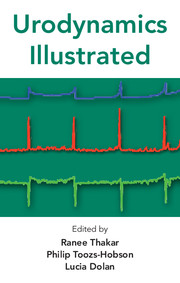Book contents
- Frontmatter
- Contents
- About the authors
- Acknowledgements
- Glossary and abbreviations
- Preface
- 1 Introduction
- 2 Setting up the equipment
- 3 Flow rate testing
- 4 Cystometry
- 5 Videocystourethrography
- 6 Ambulatory urodynamic monitoring
- 7 Urodynamic artefacts
- 8 Assessment of urethral function
- 9 Bladder diaries
- 10 Pad testing
- 11 Pre-test assessment using questionnaires
- 12 Ultrasound as a tool in urodynamics
- Index
4 - Cystometry
Published online by Cambridge University Press: 05 February 2014
- Frontmatter
- Contents
- About the authors
- Acknowledgements
- Glossary and abbreviations
- Preface
- 1 Introduction
- 2 Setting up the equipment
- 3 Flow rate testing
- 4 Cystometry
- 5 Videocystourethrography
- 6 Ambulatory urodynamic monitoring
- 7 Urodynamic artefacts
- 8 Assessment of urethral function
- 9 Bladder diaries
- 10 Pad testing
- 11 Pre-test assessment using questionnaires
- 12 Ultrasound as a tool in urodynamics
- Index
Summary
Introduction
Cystometry is the measurement of pressures inside the bladder both during the storage phase (before ‘permission to void’) and during the voiding phase (after ‘permission to void’) of urodynamics. Details of setting up the equipment for cystometry are described in chapter 2. Generic standards for subtracted dual channel cystometry can be found in the Joint Statement on Minimum Standards for Urodynamic Practice in the UK.
Prior to conducting cystometry
Residual urine
Post-void residual urine is assessed immediately prior to cystometry by a dedicated bladder scanner, conventional ultrasound scanner or via inserting and draining the residual urine through the urethral filling catheter.
The advisability of draining the post-void residual urine before cystometry is controversial and many investigators choose to perform the cystometrogram on top of any post-void residual.
Checking for urinary tract infection
Cystometry is usually postponed if the patient has a urinary tract infection because this could influence the urodynamic findings. Testing a specimen of urine with reagent strips for urinalysis with nitrites and leucocytes can provide a reasonable screening tool in the urodynamics clinic, having a sensitivity of at least 96.4% and a specificity of at least 88.5%. If nitrites and leucocytes are present, there is a strong possibility of a urinary tract infection and the cystometrogram should not be carried out. A specimen of urine should be sent for microscopy and any infection found appropriately treated.
Keywords
- Type
- Chapter
- Information
- Urodynamics Illustrated , pp. 35 - 54Publisher: Cambridge University PressPrint publication year: 2011

